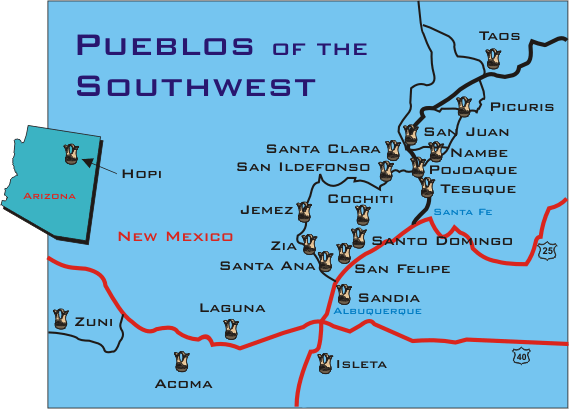 ClayHound Web
- Taos Pueblo
ClayHound Web
- Taos PuebloReturn to:
|
Taos Pueblo Pottery |
|
|
|
|
|
|
|
|
Taos Pueblo is located in north-central New Mexico. Picuris and Taos have followed pottery traditions quite different from those of the other pueblos. Their utilitarian wares more closely resemble the nearby Apache pottery in being unpainted, unpolished, and decorated, if at all, only with such sculptural features as knobs, ribbons, or punching. The unpolished surfaces of the vessels were often intentionally roughened with combings or other striations, especially in the eighteenth and nineteenth centuries. Some were constructed by pressing the clay into baskets, thus producing a characteristic surface that looks as though a corncob had been rolled over it. For perhaps a century little pottery has been manufactured at Taos Pueblos, while Picuris Pueblo has been a ceramic leader and even today produces small quantities of serviceable pottery. The Tewa Indians sometimes copied the style of Picuris and Taos but used a different clay and temper. At Taos and Picuris the clay is formed of decayed pre-Cambrian schist, filled with abundant flecks of mica throughout, while the Tewa achieved the same metallic luster by coating their clay with a thick, glittery finish. The surrounding villages of Spanish-Americans have often used and appreciated the utilitarian pottery from Picuris and Taos. Picuris pots are characterized by their mottled appearance, which varies from glittery orange metallic to almost black, while Taos pots are often more uniform in color. |
|
|
The most scenic and northernmost of all the pueblos, the Pueblo of Taos is nestled at the base of the highest mountains of New Mexico. The multi-storied adobe village was designated a World Heritage Site in 1992 and inspired what is known as the "Pueblo style" of architecture in New Mexico. Taos Pueblo spearheaded the Pueblo Revolt in 1680 which was a tribal success due to the united effort of all the pueblos.
The Pueblo at Taos is one of New Mexico's
authentic examples of the survival of Pueblo Indian life, literally
unchanged since 1540 when Coronado saw buildings and customs closely
resembling those which can be seen today. Perhaps its inaccessibility
as the most northerly of all of the Rio Grande pueblos made it more
difficult for the Spanish, and later the Anglo-Americans, to transform
its ancient ways. Perhaps the intense independence and the strong
sense of community of the Taos people helped to maintain their
cultural integrity. Despite centuries of invasion, tribal customs
remain largely unchanged. |
|
|
A strict taboo on marriage outside of the pueblo preserved racial purity even though the Taos people had friendly relationships with other tribes and non-Indians. The tradition of secrecy forbids the disclosure of many of the rituals and ceremonies of the Indian heritage to outsiders, but visitors may still enjoy the charm and hospitality of the pueblo and marvel at the superb architecture and the fine crafts of this fascinating world Because excavations in the precincts of the Taos Pueblo are forbidden, little is known of the Taos ancestors, but it is thought that they could have been either of the extinct tribes, Chaco or Anasazi. They speak the Tiwa language, as well as English. Like other pueblo people, the Taos farmed the land nearby, but their chief interest lay in the raising of horses and cattle, and in hunting. In the Sangre de Cristo mountains and the plains beyond, game was plentiful, including buffalo, elk, deer, bear, and many birds. With an abundance of animal hides, the Taos people became skilled artisans in the working of leather, fashioning of boots, moccasins and various garments, as well as drums, from this versatile material. Various festivals are held throughout the year, in June, July, September, October and November. Pole climbing is one of the skills of the Taos and is featured in some of the feasts, as well as races, a trade fair, and War Dances.
Area: 95,343 acres
from -
http://www.newmexico.org/culture/pueblo_taos.html |
|



